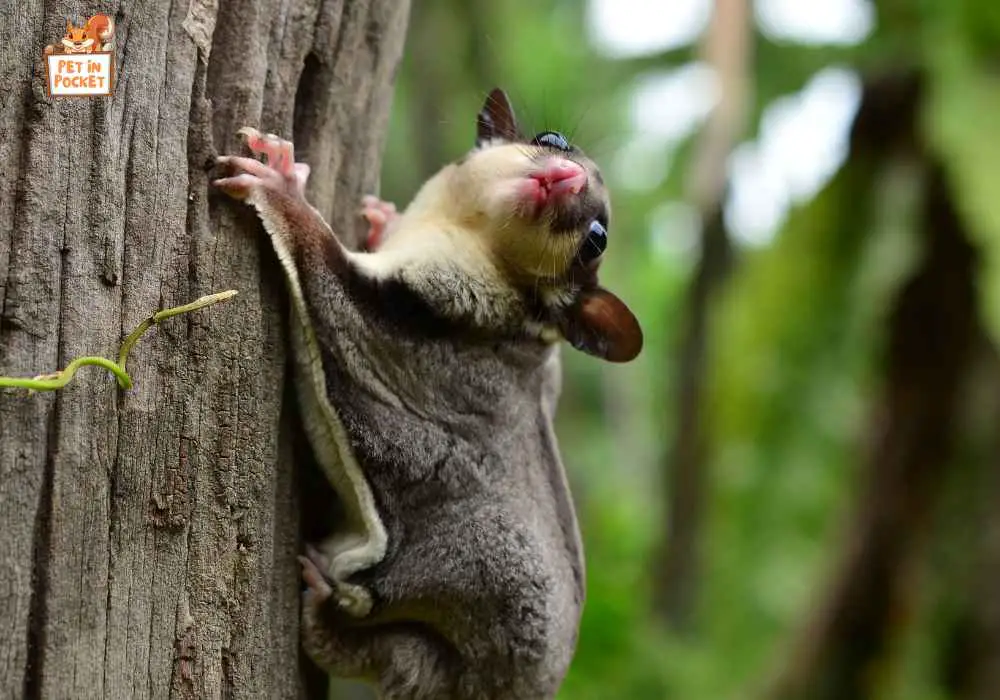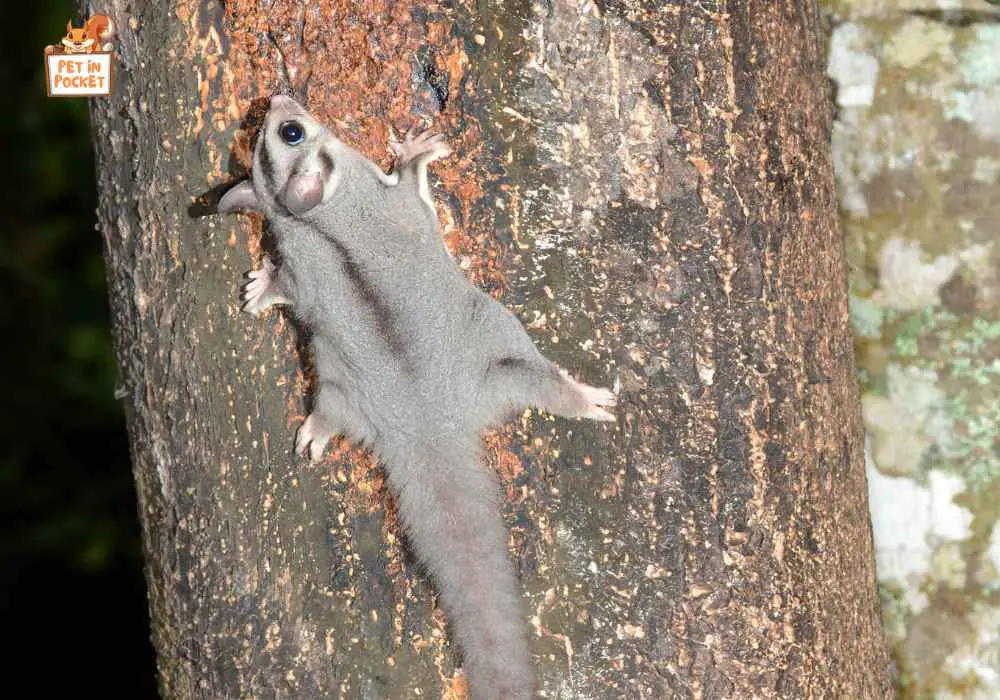Sugar Gliders are small animals. To satisfy their needs, they need an appropriate place to reside. So, where do Sugar Gliders live? You must be thinking Sugar Gliders just live in forests and captivity, you are not wrong entirely. But there are some other places where they can live. Continue to read to know more!
Table of Contents
Where Do Sugar Gliders Live?
The wild Sugar Gliders usually prefer to live in forests and woodlands. Different types of trees make their survival easy. Some people also establish nest boxes in these trees so that Gliders can live there. However, in captivity, you have to arrange a suitable environment for this animal. Let’s explore other important facts in detail –
Woodland

Woodland is a place where they find comfort to live. You will see Sugar Gliders mostly in woodland. This is a type of place where you’ll find a lot of woody trees and shrubs. Woodland is a low-density forest with the availability of plenty of sunlight. All these things have turned it into a great habitat for Sugar Gliders for its characteristics. The woodland of Australia is mostly covered with eucalyptus trees along with CallCallitris, Casuarina, Melaleuca, and Acacia. It is mostly found in the southwest of Australia. Let’s know about some of the habitable trees for Sugar Gliders in woodland!
Eucalyptus Trees: This is one of the most famous habitat trees among Sugar Gliders. They choose the tree hollow as their living place, eat the fresh leaves of this tree, and drink the tree sap dripping from the branches.
Acacia Dealbata: The gum of this tree is so useful for Glider’s health. It fills their carbohydrate demand. Both their demand for habitat and food can be managed through this tree.
Acacia Mearnsii: This large type of tree is a kind of flowering plant. Many Gliders like to defend this tree as their habitat place from the other Gliders.
Banksia Tree: This tree is a good source of pollen and nectar for Gliders. This tree is mostly found in Victoria to Queensland.
Acacia Implexa: People often call this tree “Lightwood”. The moist condition of this tree turns it into a safe option for Sugar Gliders.
Silver Wattle: The flavored gum of this tree is liked by the Gliders a lot. The tree hollow of Silver Wattle gives them enough safety and protection.
Coastal Lowland
Adjacent to the sea coast, which is mostly said as coastal land, is also a habitat place for Sugar Gliders. However, you can’t see them often on the coastline.
Rainforest

In Australia, most of the rainforests are situated in the northern and eastern parts. You will also find some in New Guinea. The third largest rainforest is situated in New Guinea. Being a social animal, Sugar Gliders live in groups and maintain small colonies in this type of forest. Moreover, Gliders are nocturnal animals and they mostly depend on trees for food and shelter.
Cities of Australia
Though you can find Sugar Gliders a lot in the forest areas of Australia, there are some prohibited rules that you must follow to keep Sugar Gliders as pets. You can pet Sugar Gliders in Victoria, South Australia, and the Northern Territory. But in Western Australia, New South Wales, the Australian Capital Territory, Queensland, or Tasmania, you are not allowed to keep Sugar Gliders as pets.
Plantation
Some of the Sugar Gliders also live in plantation areas. There are more than 1.5 hectares of plantation forest in Australia and you will find Sugar Gliders there.
Rural Garden
You will also see them in the rural gardens of Australia. In a rural garden, they can get good water supplies along with a variety of evergreen trees and movement facilities. Though you won’t see Sugar Gliders often in rural gardens, it is certainly a safe place for them to live.
How Is the Living Style of Sugar In The Forest?

In the forest, Sugar Gliders make their own nest and live as a group. Tree Hollow is their first choice for building it. Then they go for the fresh leaves to make it more habitable. Usually, Gliders love to reside in a clean environment. They keep the leaves in a circular shape and sleep in the center of it. Moreover, they can easily eat pollen, tree gum, nectar, and manna from the woodland trees. Besides, honeydew, various types of insects and spiders can be also availed by Sugar Glider from their nest.
How Sugar Gliders Live in Nest Boxes in the Wild?
A nest box can be a perfect alternative for tree hollows. It gives us actual security from any of the wild predators of the forest. Mostly in winter, Sugar Gliders can be warmer in a nest box. You can choose the perfect nest box by checking its materials, size, and resistance. Besides, choose a suitable tree for placing it and keep it at least 1-3 meters above the ground. You can future add the fresh leaves inside the box.
What is the best Living Place For Sugar Gliders?
It depends on the Sugar Glider itself. If the Sugar Glider is a wild one, the forest area is applicable for them. A wild sugar Glider cannot adapt to the captive situation. On the other hand, you should keep the captive Gliders in a home environment as they don’t have survival experience.
How To Give The Best Living Experience to Captive Sugar Gliders?
You can control the lifestyle of captive Sugar Gliders a lot. So, providing all the necessities to them should be your major concern! Here are some of the steps for making their living condition better-
- Keep Their Cage Clean: Sugar Gliders like to stay in a clean environment. So as a responsible owner, you should keep your cage clean. Moreover, deep clean their cage once a week.
- Ensure Their Safety: Sugar Gliders are an enthusiastic animal. So they engage themself with playtime and continuous movement. So any type of sharp or electric object is detrimental to them. Keep these types of things away from Sugar Gliders.
- Providing The Necessities: For a comfortable living, ensure all the necessary foods, company, and emergency support for your Gliders. Through this, you can make your Gliders surrounding a happier place.
- Create Safe Abenence: You should always maintain the temperature. It should be between 27°C to 31°C. Besides, avoid any type of direct sunlight. Along with this, the place should be well-ventilated and noise-free. If the temperature is too cool, manage a supplemental heater for them.
How Many Sugar Gliders Live Together in a Place?
In the forest around 10-15 sugar gliders live together. As they maintain a colony, it gives them a sense of safety and security. Moreover, you should put at least 2 Sugar Gliders in captivity. Sugar Gliders cannot be psychologically fit without having the company of their same species.
Conclusion
Sugar Gliders choose their habitat by measuring factors like food availability, weather, and surroundings. In captivity, they expect to have proper company and necessities. However, you will see them most in woodland. The ambiance of this place is so habitable for this small animal.
FAQ
Can Sugar Gliders live in extreme cold?
Extreme cold and extreme heat both are harmful to Gliders. Though they can tolerate the temperature from 60°F to 90°F, there must be some balance. Especially in captivity, keep the temperature moderate.
Can Sugar Gliders live in the ground?
No, Sugar Gliders cannot live on the ground. They get their necessary shelter and food from trees. It also gives them a sense of safety. So as a small animal, they should stay in trees.
What is the most important food for Sugar Gliders in the wild?
In the forest, They mostly rely on insects, small birds, and their eggs. However, the nutrients they get from the trees are also vital.
What is the most risky factor for Gliders in the wild?
In the wild, Sugar Glider suffers from many types of risks like scarcity of foods or weather disadvantages. Moreover, they can easily get hunted by big animals.
Can Sugar Gliders live alone?
Not really. Sugar Gliders don’t love to be alone. In the wild or captive, they need a consistent company of their same species.





Leave a Reply